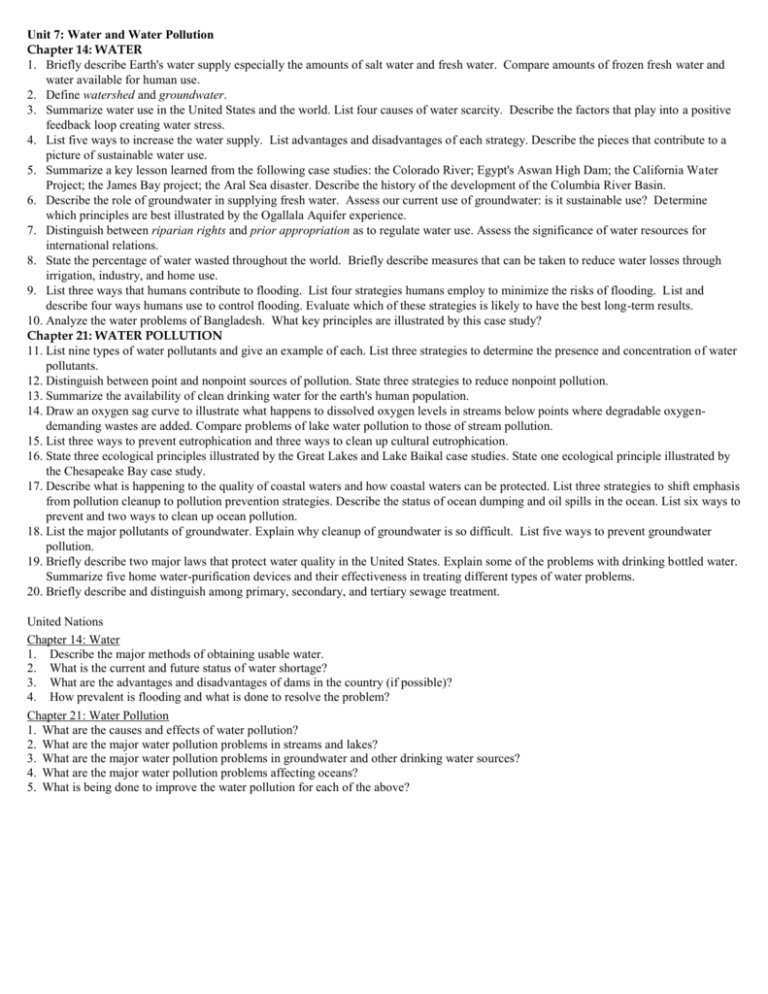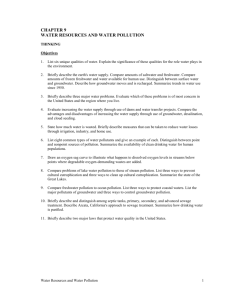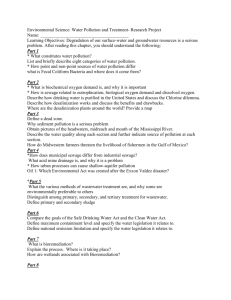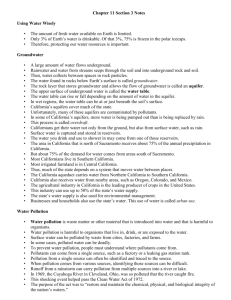Unit 7 Study Guide
advertisement

Unit 7: Water and Water Pollution Chapter 14: WATER 1. Briefly describe Earth's water supply especially the amounts of salt water and fresh water. Compare amounts of frozen fresh water and water available for human use. 2. Define watershed and groundwater. 3. Summarize water use in the United States and the world. List four causes of water scarcity. Describe the factors that play into a positive feedback loop creating water stress. 4. List five ways to increase the water supply. List advantages and disadvantages of each strategy. Describe the pieces that contribute to a picture of sustainable water use. 5. Summarize a key lesson learned from the following case studies: the Colorado River; Egypt's Aswan High Dam; the California Water Project; the James Bay project; the Aral Sea disaster. Describe the history of the development of the Columbia River Basin. 6. Describe the role of groundwater in supplying fresh water. Assess our current use of groundwater: is it sustainable use? Determine which principles are best illustrated by the Ogallala Aquifer experience. 7. Distinguish between riparian rights and prior appropriation as to regulate water use. Assess the significance of water resources for international relations. 8. State the percentage of water wasted throughout the world. Briefly describe measures that can be taken to reduce water losses through irrigation, industry, and home use. 9. List three ways that humans contribute to flooding. List four strategies humans employ to minimize the risks of flooding. List and describe four ways humans use to control flooding. Evaluate which of these strategies is likely to have the best long-term results. 10. Analyze the water problems of Bangladesh. What key principles are illustrated by this case study? Chapter 21: WATER POLLUTION 11. List nine types of water pollutants and give an example of each. List three strategies to determine the presence and concentration of water pollutants. 12. Distinguish between point and nonpoint sources of pollution. State three strategies to reduce nonpoint pollution. 13. Summarize the availability of clean drinking water for the earth's human population. 14. Draw an oxygen sag curve to illustrate what happens to dissolved oxygen levels in streams below points where degradable oxygendemanding wastes are added. Compare problems of lake water pollution to those of stream pollution. 15. List three ways to prevent eutrophication and three ways to clean up cultural eutrophication. 16. State three ecological principles illustrated by the Great Lakes and Lake Baikal case studies. State one ecological principle illustrated by the Chesapeake Bay case study. 17. Describe what is happening to the quality of coastal waters and how coastal waters can be protected. List three strategies to shift emphasis from pollution cleanup to pollution prevention strategies. Describe the status of ocean dumping and oil spills in the ocean. List six ways to prevent and two ways to clean up ocean pollution. 18. List the major pollutants of groundwater. Explain why cleanup of groundwater is so difficult. List five ways to prevent groundwater pollution. 19. Briefly describe two major laws that protect water quality in the United States. Explain some of the problems with drinking bottled water. Summarize five home water-purification devices and their effectiveness in treating different types of water problems. 20. Briefly describe and distinguish among primary, secondary, and tertiary sewage treatment. United Nations Chapter 14: Water 1. Describe the major methods of obtaining usable water. 2. What is the current and future status of water shortage? 3. What are the advantages and disadvantages of dams in the country (if possible)? 4. How prevalent is flooding and what is done to resolve the problem? Chapter 21: Water Pollution 1. What are the causes and effects of water pollution? 2. What are the major water pollution problems in streams and lakes? 3. What are the major water pollution problems in groundwater and other drinking water sources? 4. What are the major water pollution problems affecting oceans? 5. What is being done to improve the water pollution for each of the above?







